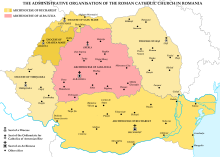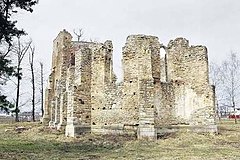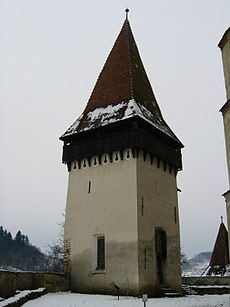Catholic Church in Romania

| Part of a series on the |
| Catholic Church by country |
|---|
 |
|
Catholicism portal |
Romanian Catholics, like Catholics elsewhere, are members of the
Most Romanian Latin Catholics inhabit the region of
The
Structure


The
The church presently runs a faculty of
| Year | Catholics (Latin Church) | Percentage |
|---|---|---|
| 1930 | 1,234,151[9] | 6.8% |
| 1948 | 1,175,000[10] | 7.4% |
| 1992 | 1,161,942[10] | 5.1% |
| 2002 | 1,028,401 | 4.7% |
| 2011 | 870,774 | 4.3% |
| 2022 | 741,276 | 3.9% |
History
Medieval period


The oldest traces of Catholic activities on present-day Romanian territory were recorded in
Other dioceses were created in
During the rule of
The Diocese of Cumania disappeared for a while, as locals took over its property, but was revived in 1332–1334, when

During the 14th century, in the years following the establishment of Moldavia and Wallachia as separate states (the
In both countries, as a result of stately emancipation and lingering conflicts with the Hungarian Kingdom, the relatively strong Catholic presence receded with the establishment of more powerful Eastern Orthodox institutions (the
Over the following centuries, the citadel of
The impact of Reformation

Following the
Religious disputes and battles prolonged themselves over the following centuries, as a large number of Latin Catholic communities founded specifically Protestant local churches — the
An unprecedented stalemate was reached in 1568, under
During that age, Latin Catholics were recognized an autonomous structure, which allowed clerics and laity to organize teaching and administrate community schools.[12] A particular compromise was the Saxon citadel of Biertan (Birthälm), where the fortified church was taken over by the majority Lutheran community, and Catholic worship was still allowed to take place in the "Catholic Tower", located just south of the religious building.[24]
The
17th century setbacks and recovery
Coinciding with the Habsburg offensives, religious conflicts were resumed and, in 1601 Bishop Demeter Napragy was forced out of Alba Iulia, with the see being confiscated by Protestants (although bishops continued to be appointed, they resided abroad).[12] By 1690, Roman Catholics were a minority in Transylvania.[23]
In parallel, Hungary-proper was integrated into Habsburg domains (1622), which created a new base for Counter-Reformation, as well as a local seat for the
Around that time, the ethnic Romanian Transylvanian intellectual
During the late 17th and early 18th centuries, the Catholic Church sought to obtain the adherence of non-Catholic Christians to the Eastern Catholic Churches. They were assisted in this effort by the Habsburg offensive into Eastern Europe, which brought about Emperor Leopold I's conquest of Transylvania in 1699.[2][23] An additional factor for the new Catholic successes was, arguably, the continuous fighting between the various Protestant denominations of Transylvania.[3]
In 1657, Armenians in Transylvania who belonged to the Armenian Apostolic Church and were led by Bishop Oxendius Vărzărescu, placed themselves under indirect Roman Catholic jurisdiction, as part of the Armenian Catholic Church.[27] Michael I Apafi, a Transylvanian prince, allowed the resettling of 600 Armenian families from Moldavia in 1672, elevating 55 of the families to nobility. The Armenians–which included a Catholic contingent–created trading towns, with Gherla (Armenopolis or Szamosújvár) the most prominent.[28][27] Some Transylvania Romanian Orthodox would join with Rome in 1698.[29]
18th century
Under the rule of Emperor
In 1700, with Jesuit assistance, the
Romanian Greek Catholic autonomy was challenged by the Diocese of Ardeal's Latin bishop in 1721. The Latin bishop, invoking the
In the late 18th and early 19th centuries, Moldavia and Wallachia were awarded their own
In addition to the local presence, the
19th century and early 20th centuries

In 1812, the Franciscan
Following the Moldo-Wallachian union of 1859, and the 1881 creation of the Kingdom of Romania, the seat in Bucharest became an archdiocese (April 7, 1883) and the one in Iaşi a diocese, replacing the Franciscan-led diocese of Bacău (June 27, 1884).[2][26][30] This came as a consequence of repeated protests from locals, who called for Romanian clerics not to be under the strict control of foreign bishops.[34] Upgrading the local ecclesiastical hierarchy, the move also led to the disestablishment of the Cioplea bishopric.[33] The first Archbishop of Bucharest was Ignazio Paoli.[34]
The
In parallel, autonomy for Latin Catholic school administration in Austro-Hungarian Transylvania was recovered in 1873, through the creation of a "Roman-Catholic Status".[12] Among the Romanian Greek Catholics, the blanket policy of granting annulments for marriages involving adultery was suppressed during the 19th century. This practice, typical to the Romanian Orthodox, was considered an "abuse" by the Catholic Church.[32]
World War I and Greater Romania

During the final years of World War I and the stages leading up to Transylvania's union with Romania, Catholicism in Romania met with several diplomatic problems. Romania was defeated by the Central Powers and signed the Treaty of Bucharest, but its diplomats remained active in Allied countries, setting up the National Romanian Council in Paris. The latter, which also represented Romanian groups in the Austro-Hungarian-ruled Transylvania and Bukovina, appointed Monsignor Vladimir Ghika as its representative in Vatican City.[37]
During the interwar years, Romanian national identity was molded to emphasize the Romanian Orthodox Church at the exclusion of other religious groups including Latin and Greek Catholics and Protestants. Trăirism, an anti-Western Romanian political theory led by
When the
Subsequently, the Latin Catholic presence registered significant successes: new religious institutes, such as the
A Concordat was negotiated in 1927, being ratified by the Romanian side in 1929[2][42][43] and through the papal bull Solemni conventione on June 5, 1930.[44] On the basis of it, a 1932 agreement assigned the Latin Church all the Transylvanian assets previously administered by the "Roman-Catholic Status".[2] On August 15, 1930, the bishop of Bucharest was appointed metropolitan (the others becoming suffragans).[45]
A redefinition of ecclesiastical administration took place in formerly Austro-Hungarian provinces, corresponding with the new borders of Greater Romania: Latin Catholics in Bukovina became part of the
Communist period
Both the Latin Church and the
In 1946, the Groza cabinet declared Apostolic Nuncio
The 1927 Concordat was unilaterally denounced on July 17, 1948[42][47] In December of the same year, the Greek-Catholic Church was disestablished, and its patrimony was passed to the Eastern Orthodox Church.[3][42][49] At least 70 Eastern Orthodox clergy were imprisoned for refusing to take over the seized Romanian Greek Catholic churches.[5] However, the general absorption of the Romanian Greek Catholics' property and clergy into the Romanian Orthodox Church was achieved, serving as perhaps the clearest example of how the Romanian Orthodox Church's cooperation with communist authorities elevated its societal standing.[39] Those Romanian Greek Catholics who left their church generally joined the Romanian Orthodox Church for its inherent Romanian identity. Others joined the Hungarian-majority Latin Church, leaving the Romanian Greek Catholic Church isolated and with only 10 percent of its pre-communist membership.[50]
New state regulations were designed to abolish papal authority over Catholics in Romania, and the Latin Church, although it was one of the sixteen recognized religions, lacked legal standing, as its organizational charter was never approved by the Department of Cults.[2][42][47] Until 1978, the celebration of Catholic Mass in Romanian language outside Bucharest and Moldavia was forbidden by the government.[51] Many foreign clerics, including the Jesuit superiors,[25] were intimidated and ultimately expelled.[47][48] The Apostolic Nunciature was also closed down on government orders in 1950, after O'Hara left the country.[48] By that year, Romania, like all other Eastern Bloc countries, cut off diplomatic contacts with the Holy See.[52] Only two dioceses were allowed (the Bucharest Diocese and the Alba Iulia Diocese),[2][48] while the banned ones continued to function in semi-clandestinity (their new bishops, appointed by the Holy See, were not formally recognized).[2] The Communists unsuccessfully attempted to convince Catholics to organize themselves into a national church, and to cease their contacts with the Holy See.[47]
Many Latin Catholic clerics, alongside their approximately 600 Greek-Catholics counterparts,
In 1962, the Catholic population of Romania was reckoned at around 1.5 million Romanian Greek Catholics (primarily in Transylvania), 1.5 million Latin Catholics of mostly Hungarian and German ethnicity, with the Armenian Catholic population primarily found in the longstanding Transylvanian community.[5] During the relative liberalization of the 1960s, sporadic talks between the Holy See and the Romanian state were carried out over the status of Romanian Greek Catholic possessions, but without any significant result.[3] Romania became a Jesuit Province by 1974 (numbering, at that time, eight priests and five brothers).[25]
Post-1989
The situation normalized soon after the
Beginning in the 1980s, the Romanian Roman Catholic Church has taken part in several international gatherings to promote
See also
- Religion in Romania
- Freedom of religion in Romania
- Romanian Orthodox Church
- Evangelical Church of Romania
Notes
- ^ (in Romanian) "Primele date provizorii pentru Recensământul Populației și Locuințelor, runda 2021 "; retrieved January 7, 2022
- ^ Ministry of Culture and Religious Affairs, Under-Secretariat for Culture and Religious Affairs; retrieved February 21, 2015
- ^ ISBN 0-8223-1241-7
- ^ a b Diversitate etnoculturală în Europa, at the Resource Center for Ethno-cultural Diversity; retrieved July 25, 2007
- ^ a b c d e Attwater, Donald, ed. (1962). "Ruminia, The Church in". A Catholic Dictionary (3rd ed.). The Macmillan Company. pp. 439–440.
- ^ Attwater, Donald, ed. (1962). "Armenian Rite, Catholics of the". A Catholic Dictionary (3rd ed.). The Macmillan Company.
- Ministry of Culture and Religious Affairs, Under-Secretariat for Culture and Religious Affairs; retrieved July 25, 2007
- ^ Ministry of Culture and Religious Affairs, Under-Secretariat for Culture and Religious Affairs; retrieved July 25, 2007
- ^ Sorin Negruți (2014). "The evolution of the religious structure in Romania since 1859 to the present day" (PDF). Revista Română de Statistică (6): 43.
- ^ a b New Catholic Encyclopedia, vol 12, p. 335
- ^ Ştefănescu, p.79, 128-131
- ^ Encyclopedia Press, New York, 1913
- ^ a b c Ştefănescu, p.80
- ^ a b Ştefănescu, p.112
- ^ a b c Ştefănescu, p.116
- ^ Ştefănescu, p.74-76
- ^ Ştefănescu, p.93
- ^ a b Ştefănescu, p.94
- ^ Encyclopedia Press, New York, 1913
- ^ Ştefănescu, p.16, 76
- ^ Ştefănescu, p.76
- ^ a b Vasile Maciu, "Costche Negri, un ctitor al României moderne", in Magazin Istoric, May 1975, p.68
- ^ ISBN 0-521-84154-2
- ISBN 0-7506-3279-8
- ^ a b c d e f g h i j k l m n o p (in Romanian) "Repere istorice" Archived 2008-04-11 at the Wayback Machine, at the Society of Jesus in Romania; retrieved July 25, 2007
- ^ a b (in Romanian) Jean Nouzille, "Ceangăii din Moldova" Archived 2009-05-07 at the Wayback Machine, in Magazin Istoric, February 2003; retrieved July 29, 2007
- ^ România Liberă, March 7, 2007; retrieved July 25, 2007
- ^ "Head of Armenian Catholic Church Decorates Viktor Orbán". Hungary Today. 2 November 2022. Retrieved 4 April 2023.
- ^ "Eastern rite church". Encyclopædia Britannica. 1998. Retrieved 2 April 2023.
- ^ a b c d e Preda & Bucur, p.56
- ^ a b c d e f Preda & Bucur, p.57
- ^ a b Attwater, Donald (1937). The Catholic Eastern Churches (Revised ed.). Milwaukee, WI: The Bruce Publishing Company. p. 102.
- ^ Encyclopedia Press, New York, 1913
- ^ Encyclopedia Press, New York, 1913
- ^ Giurescu, p.62, 269, 273
- ^ Giurescu, p.272-274
- ^ Preda & Bucur, p.56-57
- S2CID 36815615.
- ^ a b Ediger, Ruth M. (Fall 2005). "History of an Institution as a Factor for Predicting Church Institutional Behavior: the Cases of the Catholic Church in Poland, the Orthodox Church in Romania, and the Protestant Churches in East Germany". East European Quarterly. 39 (3).
- ^ Preda & Bucur, p.58
- ^ Preda & Bucur, p.58-59
- ^ ISBN 973-669-175-6
- ^ Preda & Bucur, p.59
- ^ New Catholic Encyclopedia, vol 12, p. 332
- ^ ISBN 0-405-02747-8
- ^ "Armenian Catholic Church". Encyclopædia Britannica. 1998. Retrieved 2 April 2023.
- ^ a b c d e f g h i Cristian Vasile, "The Apostolic Nunciature in Romania at the Beginning of the Communist Regime", in Annuario. Istituto Romeno di cultura e ricerca umanistica, 4 (2002); retrieved July 26, 2007
- ^ ISBN 0-7546-3610-0
- ^ ISBN 1-85743-186-3
- ^ Orlich, Ileana Alexandra. "Understanding Latent Religious Conflict: The Case of Frictions Between the Greek Catholic and Orthodox Churches in Romania". Eastern European Quarterly. 42 (4): 409.
- ^ New Catholic Encyclopedia, vol 12, p. 334
- ^ a b Associated Press, "Evolution in Europe; Links to the Vatican Restored by Romania", in The New York Times, May 16, 1990
- ^ New Catholic Encyclopedia, vol 12, p. 333
References
- OCLC 1279610
- (in Romanian) Dumitru Preda, Marius Bucur, "România – Vatican. 80 ani de relaţii diplomatice", in Magazin Istoric, May 2000
- Ştefan Ştefănescu, Istoria medie a României, Vol. I, Bucharest, 1991
- New Catholic Encyclopedia. Vol. 12. 2nd ed. Detroit: Gale, 2003. p329-337. 15 vols. entry: Romania

